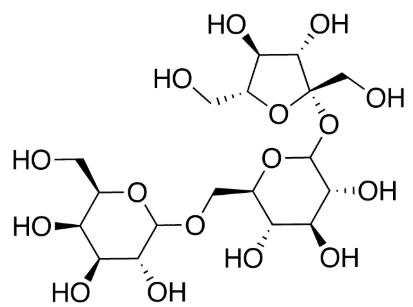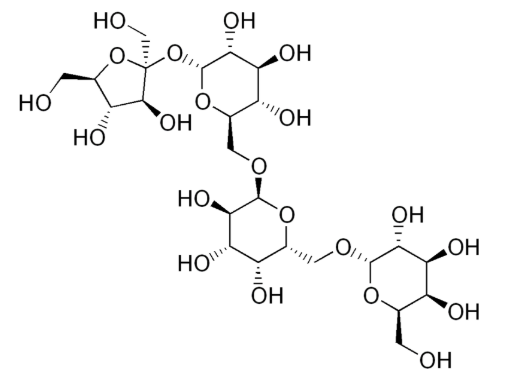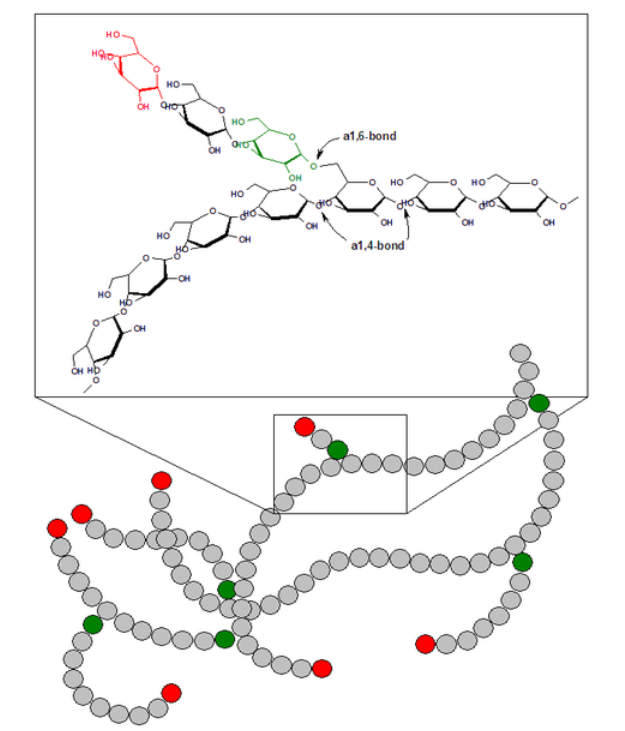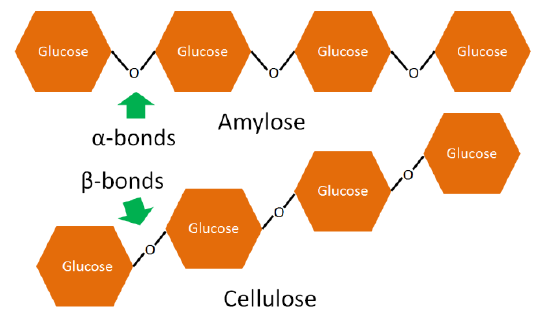2.2: Carbohydrates - Complex Carbohydrates
- Page ID
- 41601
Oligosaccharides
Within complex carbohydrates, there are oligosaccharides and polysaccharides. Oligosaccharides (oligo means few) are composed of 3-10 monosaccharides bonded together and polysaccharides contain greater than 10 monosaccharides bonded together. Refer to Figure \(\PageIndex{1}\) for a general overview of carbohydrates.
Raffinose and stachyose are the most common oligosaccharides. They are found in legumes, onions, broccoli, cabbage, and whole wheat11. The link below shows the raffinose and stachyose content of some plant foods.
The structures of the two oligosaccharides are shown below.


Our digestive system lacks the enzymes necessary to digest these alpha 1-6 glycosidic bonds found in oligosaccharides. As a result, the oligosaccharides are not digested and reach the colon where they are fermented by the bacteria there. Gas is produced as a byproduct of this bacteria fermentation that can lead to flatulence. To combat this problem, Beano® is a popular product that contains an enzyme (alpha-galactosidase) to break down oligosaccharides, thereby preventing them from reaching the colon and being fermented to produce gas.
Polysaccharides
Poly means "many" and thus polysaccharides are made up of many monosaccharides (>10). There are 3 main classes of polysaccharides: starch, glycogen, and most fibers. The following sections will describe the structural similarities and differences between the 3 classes of polysaccharides that are divided as shown in Figure \(\PageIndex{1}\).
Starch
Starch is the storage form of glucose in plants. There are two forms of starch: amylose and amylopectin. Structurally they differ in that amylose is a linear polysaccharide, whereas amylopectin is branched. The linear portion of both amylose and amylopectin contains alpha 1-4 glycosidic bonds, while the branches of amylopectin are made up of alpha 1-6 glycosidic bonds.


Amylopectin is more common than amylose (4:1 ratio on average) in starch11,26. Some starchy foods include grains, root crops, tubers, and legumes.
Glycogen
Glycogen is similar to starch in that it is a storage form of glucose. Glycogen, however, is the carbohydrate storage form in animals, rather than plants. It is even more highly branched than amylopectin, as shown below.

Like amylopectin, the branch points of glycogen are alpha 1-6 glycosidic bonds, while the linear bonds are alpha 1-4 bonds. The figure below shows that the difference between these bonds (1-4 vs. 1-6) are carbons in the glucose carbons involved.

The advantage of glycogen's highly branched structure is that the multiple ends (shown in red above) are where enzymes start to cleave off glucose molecules. As a result, with many ends available, it can provide glucose much more quickly to the body than it could if it was a linear molecule like amylose with only two ends. We consume almost no glycogen, because it is rapidly broken down by enzymes in animals after slaughter7.
Fiber
The simplest definition of fiber is indigestible matter. Indigestible means that it survives digestion in the small intestine and reaches the large intestine.
There are 3 major fiber classifications28:
- Dietary Fiber - nondigestible carbohydrates and lignin that are intrinsic and intact in plants
- Functional Fiber - isolated, nondigestible carbohydrates that have beneficial physiological effects in humans
- Total Fiber - dietary fiber + functional fiber
The differences between dietary and functional fiber are compared in the table below:
| Dietary Fiber | Functional Fiber |
|---|---|
| Intact in plants | Isolated, extracted, or synthesized |
| Carbohydrates + lignins | Only carbohydrates |
| Only from plants | From plants or animals |
| No proven benefit | Must prove benefit |
Dietary fiber is always intact in plants, whereas functional fiber can be isolated, extracted or synthesized. Functional fiber is only carbohydrates, while dietary fiber also includes lignins. Functional fiber can be from plants or animals, while dietary fiber is only from plants. Functional fiber must be proven to have a physiological benefit, while dietary fiber does not.
Polysaccharide fiber differs from other polysaccharides in that it contains beta-glycosidic bonds (as opposed to alpha-glycosidic bonds). To illustrate these differences, consider the structural differences between amylose and cellulose (type of fiber). Both are linear chains of glucose, the only difference is that amylose has alpha-glycosidic bonds, while cellulose has beta-glycosidic bonds as shown below.

The beta-bonds in fiber cannot be broken down by the digestive enzymes in the small intestine so they continue into the large intestine.
Fiber can be classified by its physical properties. In the past, fibers were commonly referred to as soluble and insoluble. This classification distinguished whether the fiber was soluble in water. However, this classification is being phased out in the nutrition community. Instead, most fibers that would have been classified as insoluble fiber are now referred to as nonfermentable and/or nonviscous and soluble fiber as fermentable, and/or viscous because these better describe the fiber's characteristics29. Fermentable refers to whether the bacteria in the colon can ferment or degrade the fiber into short chain fatty acids and gas. Viscous refers to the capacity of certain fibers to form a thick gel-like consistency. The following table lists some of the common types of fiber and provides a brief description about each.
| Fiber | Description |
|---|---|
| Cellulose | Main component of plant cell walls |
| Hemicellulose | Surround cellulose in plant cell walls |
| Lignin | Noncarbohydrate found within “woody” plant cell walls |
| Fiber | Description |
|---|---|
| Hemicellulose | Surround cellulose in plant cell walls |
| Pectin | Found in cell walls and intracellular tissues of fruits and berries |
| Beta-glucans | Found in cereal brans |
| Gums | Viscous, usually isolated from seeds |
The following table gives the percentage of total dietary fiber in 5 foods.
| Food | Total Dietary Fiber |
|---|---|
| Cereal, all bran | 30.1 |
| Blueberries, fresh | 2.7 |
| Broccoli, fresh, cooked | 3.5 |
| Pork and beans, canned | 4.4 |
| Almonds, with skin | 8.8 |
The table below shows the amount of nonfermentable, nonviscous fiber in these same five foods.
| Food | Hemicellulose | Cellulose | Lignin | Total |
|---|---|---|---|---|
| Cereal, all bran | 15.3 | 7.5 | 4.3 | 27.1 |
| Blueberries, fresh | 0.7 | 0.4 | 0.9 | 2.0 |
| Broccoli, fresh, cooked | 0.9 | 1.2 | 0.3 | 2.4 |
| Pork and beans, canned | 0.9 | 1.6 | 0.2 | 2.7 |
| Almonds, with skin | 1.8 | 3.3 | 1.9 | 7 |
The table below shows the amount of fermentable, viscous fiber in these same five foods.
| Food | Hemicellulose | Pectin | Total |
|---|---|---|---|
| Cereal, all bran | 2.0 | 0.1 | 2.1 |
| Blueberries, fresh | 0.1 | 0.2 | 0.3 |
| Broccoli, fresh, cooked | 0.2 | 0.2 | 0.4 |
| Pork and beans, canned | 1.1 | 0.3 | 1.4 |
| Almonds, with skin | 0.2 | tr | 0.2 |
tr = trace amounts
Foods that are good sources of nonfermentable, nonviscous fiber include whole wheat, whole grain cereals, broccoli, and other vegetables. This type of fiber is believed to decrease the risk of constipation and colon cancer, because it increases stool bulk and reduces transit time11. This decreased transit time theoretically means shorter exposure to consumed carcinogens in the intestine, and thus lower cancer risk.
Fermentable, viscous fiber can be found in oats, rice, psyllium seeds, soy, and some fruits. This type of fiber is believed to decrease blood cholesterol containing lipoproteins and glucose concentrations, thus also lowering the risk of heart disease and diabetes, respectively11. Its viscous nature slows the absorption of glucose preventing blood glucose from spiking after consuming carbohydrates. It lowers blood cholesterol concentrations primarily by binding bile acids, which are made from cholesterol, and causing them to be excreted. As such, more cholesterol is used to synthesize new bile acids.
References
- http://www.fda.gov/food/ingredientsp.../ucm324856.htm
- www.foodnavigator-usa.com/Mar...eeteners-drops
- https://pubchem.ncbi.nlm.nih.gov/com...ol#section=Top
- https://pubchem.ncbi.nlm.nih.gov/com...ol#section=Top
- https://pubchem.ncbi.nlm.nih.gov/com...ol#section=Top
- Wardlaw GM, Hampl J. (2006) Perspectives in nutrition. New York, NY: McGraw-Hill.
- Whitney E, Rolfes SR. (2008) Understanding nutrition. Belmont, CA: Thomson Wadsworth.
- http://en.Wikipedia.org/wiki/File:Tagatose.png
- www.fda.gov/AboutFDA/Transpar.../ucm214865.htm
- http://www.fda.gov/food/ingredientsp.../ucm397725.htm
- Byrd-Bredbenner C, Moe G, Beshgetoor D, Berning J. (2009) Wardlaw's perspectives in nutrition. New York, NY: McGraw-Hill.
- Fernstrom JD, Munger SD, Sclafani A, de Araujo IE, Roberts A, Molinary S (2012) Mechanisms for Sweetness. J Nutr 142 (6) 1134S–1141S.
- Behrens M, Blank K, Meyerhof W. (2017) Blends of Non-caloric Sweeteners Saccharin and Cyclamate Show Reduced Off-Taste due to TAS2R Bitter Receptor Inhibition. Cell Chem Biol 24 (10) 1199-1204.
- https://en.Wikipedia.org/wiki/Saccha...:Saccharin.svg
- en.Wikipedia.org/wiki/Aspartame
- en.Wikipedia.org/wiki/File:Neotame.png
- en.Wikipedia.org/wiki/File:Advantame.svg
- en.Wikipedia.org/wiki/File:AcesulfameK.svg
- en.Wikipedia.org/wiki/File:Sucralose2.svg
- en.Wikipedia.org/wiki/File:Steviol.svg
- Carakostas MC, Curry LL, Boileau AC, Brusick DJ. (2008) Overview: The history, technical function and safety of rebaudioside A, a naturally occurring steviol glycoside, for use in food and beverages. Food and Chemical Toxicology 46 Suppl 7: S1.
- en.Wikipedia.org/wiki/File:Steviosid.svg
- en.Wikipedia.org/wiki/File:Mogroside_II_E.gif
- en.Wikipedia.org/wiki/File:Raffinose.png
- en.Wikipedia.org/wiki/File:Stachyose.png
- Stipanuk MH. (2006) Biochemical, physiological, & molecular aspects of human nutrition. St. Louis, MO: Saunders Elsevier.
- en.Wikipedia.org/wiki/File:Glycogen.png
- DRI Book - [Anonymous]. (2005) Dietary reference intakes for energy, carbohydrate, fiber, fat, fatty acids, cholesterol, protein, and amino acids. Washington, D.C.: The National Academies Press. https://www.nap.edu/read/10490/chapter/9
- Dietary Reference Intakes: Proposed Definition of Dietary Fiber Food and Nutrition Board. 2001 https://www.nap.edu/read/10161/chapter/3
- Marlett JA. (1992) Content and composition of dietary fiber in 117 frequently consumed foods. J Am Diet Assoc 92: 175-186.


